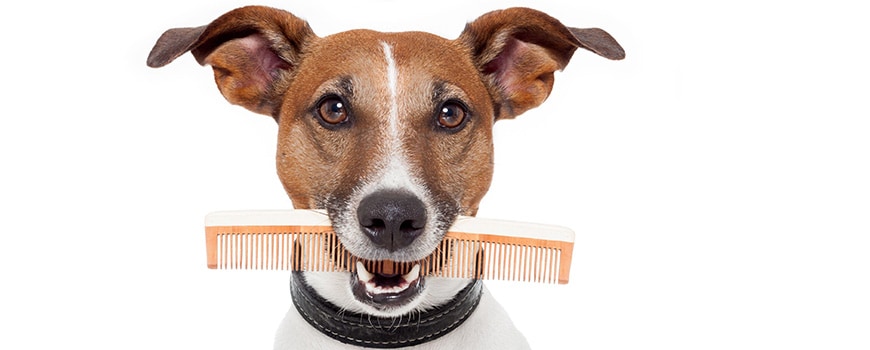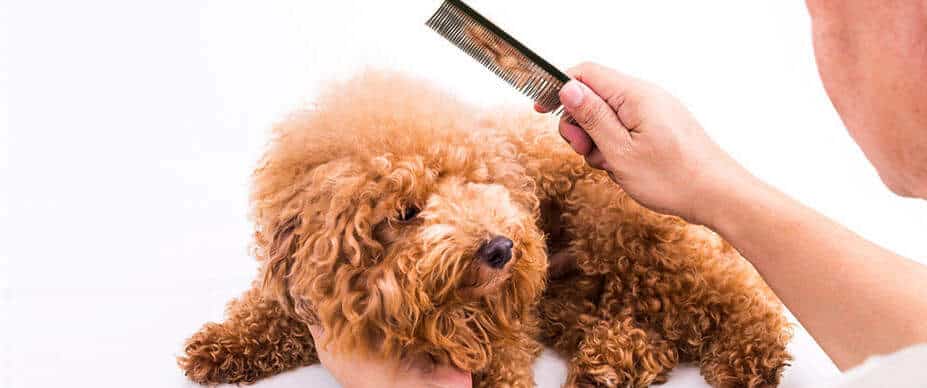Knots, tangles, mats and wadding are all terms that are used to describe a formation where some hairs have become intertwined and tightly locked to their neighbours. The severity of this problem can vary considerably, ranging from a tangle of a few hairs to a large knot involving large areas of coat.
Although it may well appear that it is the topcoat that is responsible, it is more often than not the undercoat that is the culprit.
Mats, tangles and knots tend to be a confused mass or cluster of hairs hanging either within or from the coat. They can often be isolated for special attention and they are usually removed by splitting up the mass with de-matting tools and breaking it down by brushing until it eventually disperses.
Wadding tends to be used to describe undercoat hair that has come away from the skin and formed a thick felt layer within the remaining coat. It is generally harder to remove because it covers large areas and can sometimes be very dense. Where the hair has come away from the skin, tools can be inserted behind the wad and gently dragged through the coat.
If, however, the wad has not entirely left the skin, its removal is far more challenging: the hair will be tight and in some cases the skin may be raised in some areas by the tightening hairs. The skin is likely to be traumatized and care must be taken not to make the situation worse.
You have a selection of tools to work with here. De-matting tools are very sharp, so make sure you hold them firmly and correctly as you will experience some resistance from the coat as you try to remove the tangled masses.
De-matting Technique
The first method to try is teasing it apart with your fingers. Sometimes, if the mat is not too large, or if it is close to the surface, it is possible to break it up with just your fingers. As the mass starts to break down, use a slicker brush to break it up further and disperse it.
If possible, try to isolate the mass from the surrounding coat so that you can concentrate on a specific area. If the knot is small, and you have a good view of the mass, insert a de-matter behind the mat and, using the tool according to the required blade action, work the tool towards the end of the coat. The knot should come away reasonably easily.
If the knots are compacted and cover large areas of coat, you need to select one area at a time and, by inserting the de-matting tool, start to pick your way through to the skin. In these cases a short-toothed mat-breaker may be preferable because the blades are easier to insert into the coat and the action allows you more control over where the blades are cutting.This reduces any tendency you may have to pull too strongly or forcefully.
Another method involves the use of thinning scissors. These are particularly useful when you are working in an area where it is easy to cut the skin, or if you are working on a dog that will not stand still. A single cut from the thinning scissors can be used at the base of the knot, close to the skin, to reduce the density of the hair. The knot is then brushed with a slicker to break it up, and finished with a de-matter.
There are times, particularly if you are working with badly matted wool coats, when de-matting tools simply cannot get into the coat. In such cases you may need to use clippers and remove either part of the coat or, indeed, all of it.
On a healthy dog, it would be a rare thing to have to clip off the entire coat. On older dogs, however, where muscle formation is poor, it may be an option worth considering. This is mainly because grooming out is often so time consuming; the dog must brace himself against the pull of the brush or comb and this can easily exhausts an old dog.
Another option, of course, would be to groom the dog over several sessions.
Clipping off a badly matted coat is not always easy and it is not a job that can be done in a hurry. Sometimes it is not easy to see any areas of skin, so you may have no idea of what you are going to find.
There are two ways to remove a coat in this condition:
METHOD 1
Start by selecting a medium-length skip-toothed blade. Make or find a gap in the coat to insert your clipper and start clipping slowly. If you try to clip in a hurry, forcing the blade through, it will snag and pull on the skin. The blade may struggle to slide through the coat, placing unnecessary strain both on the skin and on the clipper motor.
If the blade is struggling, try using a slightly shorter length. You may have to change blade length a couple of times before you find a length that will cut the coat, but do remember to try to leave a covering of hair. In many cases the coat will come off in large pieces.
METHOD 2
Sometimes, even a clipper with a fine blade will struggle to get into the coat and clip it off. It is most likely to be a wool coat that presents you with this problem because the coat is long, dense and very sticky. The hairs will still be firmly attached to the dog and there will be a fair amount of dirt and debris contributing to the mess.
To make things even more difficult, a heavy coat may present to you damp because once it gets wet, it is often unable to dry out properly and becomes more easily knotted.
Have a good feel of the dog to establish the depth of coat. Use an old pair of scissors to cut down some of the coat length. Brush the coat with a longer-toothed slicker. This will start to break up some of the hair and long fuzzy strands will start to stretch out from the coat. Cut the long fuzzy strands down and brush again.
Continue doing this until the coat has either broken up enough to get a clipper blade into it or until you have trimmed it down short enough to brush the remaining mats out.
If you opt to brush, do so with care because the skin may be sore or very sensitive, and it will be within reach of your brush strokes. This is particularly important if the dog arrived with a wet and dirty coat.

